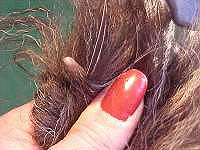Dermatomyositis in Shelties
Symptoms include: Spotty Hair Loss on the eyes, ears, tail, feet (see pictures below)
DMS is short for Dermatomyositis
Dermatomyositis (DM) AKA.....Sheltie Skin Syndrome, Sheltie Skin Disease
More recently called DMS
DMS in Shelties should NOT be confused with Demodectic Mange. This is a totally separate disease.
DMS is known by several names in the Sheltie world. But most of us call it "DMS".
First and Foremost, DMS is not a death sentence. Nor is it a good reason to not adopt a Sheltie who has it. Shelties with DMS are just as sweet and loving as any other Sheltie and just as deserving of a home. Often they are given up because of the owners lack of understanding the disease, or because an owner does not want a dog with scars on his face. It is so sad.
DMS is NOT contagious, so no need to worry about people or about your other animals contracting this disease. Repeat: It is not contagious.
Dermatomyositis is an inherited disorder that can cause skin lesions and in severe cases, affect the muscles of shelties and collies. DMS primarily affects Collies and Shetland Sheepdogs, although is seen occasionally in other breeds.
DMS is hereditary. Any Sheltie with this disease should NOT be bred. All infected Shelties should be spayed and neutered. If you know of anyone, knowingly, breeding DMS affected dogs... please write to us and let us know.
DMS will usually begin on the head and ears and the front legs of a sheltie. The dog will have hair loss and a small lesion will appear. The lesions may have a white or yellow crust or they may appear to be an area of dry flaky skin or just a small bald spot. DMS outbreaks can be quite mild or very severe. If the outbreak is mild enough, some owners may not even notice the small patch of hair loss. But a more severe outbreak usually sends most pet owners to the vet's office. More than likely, the vet will do a scrape for mange, and discuss allergies and may try a wide range of things............all that will do nothing (if it is DMS). Often the vet is left with no idea what is wrong with the dog, which sadly sends the owner of to yet another vet still seeking answers. Fortunately, many internet users can get online and find pages like this one and get the answers they need.
Sadly, many vets have never heard of this disease, let alone seen or worked with it. Since it mainly appears in Shelties and Collies, it is not something vets have much chance to learn much about. This is not unusual or a sign of a bad vet, so please do not blame your vet for not recognizing it. Vets are required to learn diseases of all animals, and seldom see diseases that only occur in one or two breeds. Instead, please have your vet contact one of the DM experts listed on one of these websites. By enlightening your vet to this disease, you could save the next Sheltie owner from going through the frustration that you have.
Skin lesions occur in areas of trauma. The gums, tips of the ears, skin on the bridge of the nose and face, around and under the eyes, skin over the joints and toes of the limbs, and tip of the tail are common sites of involvement.
Most often, and in this writers opinion, the very tip (end) of the tail is a pretty sure sign of DMS. In true DMS cases, I almost always find a bald tail-tip.
Skin lesions can heal rapidly without treatment or persist and worsen with time. In dogs which don't heal rapidly, it can take months before the extent of the skin lesions is known.
Skin lesions are variable in size and are hairless, red, and scaly or crusty. In most dogs, the lesions are not itchy. The skin lesions seen in Dermatomyositis are not unique to this disease. Dogs with ringworm, bacterial skin infection, Demodectic mange, and discoid lupus, to name a few, can have similar lesions. No one can make the diagnosis of Dermatomyositis or exclude that diagnosis simply by looking at the dog. Diagnostic tests must be performed. Skin biopsies are very important especially if the dog or any of its relatives are to be used for breeding.
Diagnosis: The only way to diagnose DMS is through a skin punch biopsy evaluated by a dermapathologist. The biopsy needs to be done on an active lesion. An active lesion need not be crusty, it may just be an area of hair loss. DMS is probably often overlooked or misdiagnosed as allergies or Demodectic mange. There are a number of conditions that produce similar symptoms, which is why it is so important to do a biopsy. A positive skin scraping for Demodectic mange does not rule out DMS, as it is possible for the dog to have both. Research is currently being done to try and identify the gene(s) responsible for DMS. Once the gene(s) are identified, hopefully a DNA test can be developed.
Treatment: There is no cure for DMS. The usual treatment is with steroids. Mild cases may clear up without treatment, but more severe cases may require long tern steroid use. "Clear up" however, just means going into remission. There is no cure for this disease.
DMS legions will come and go. Stress seems to aggravate DMS. Stress can be defined as having surgery, new family members, coming into season, illness, or prolonged fear (being a stray).
Information on Dermatomyositis is available to veterinarians and the lay public in a variety of veterinary publications. The newest and most widely available is in Muller and Kirk's: Small Animal Dermatology - 5th ed. Philadelphia: W.B. Saunders, 1995, pages 759-764. If the information below is published, please put that reference as the source so your readers and their veterinarians will know where to go to get more complete details. There is also some more information here at the Dogpatch, courtesy of Kim Schive.
If you or your vet would like more information on DMS, our suggested contact(s) are:


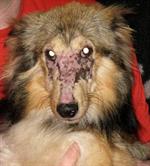

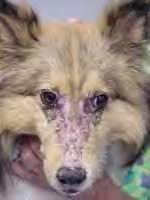

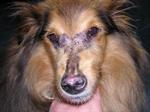


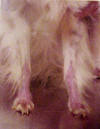

Here is a small collection of extreme photos of DMS Fortunately most cases are not this extreme. In fact, many times you will not notice any symptoms at all.
Note: Most of these dogs, except for DMS, are otherwise healthy and the lesions on the face are not infected. Stress makes DM worse, and dogs that are not healthy, or have not had good vet care may often look much worse than these pictures.










